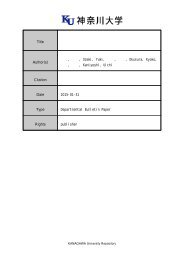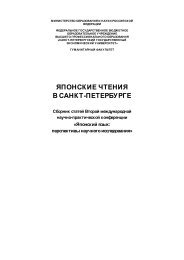to Learners with Special Educational Needs
e-textbook SEN
e-textbook SEN
Create successful ePaper yourself
Turn your PDF publications into a flip-book with our unique Google optimized e-Paper software.
Pokrivčáková, S. et al. (2015). Teaching Foreign Languages <strong>to</strong> <strong>Learners</strong> <strong>with</strong> <strong>Special</strong> <strong>Educational</strong> <strong>Needs</strong>:<br />
e-textbook for foreign language teachers. Nitra: Constantine the Philosopher University. 128 p.<br />
ISBN 978-80-558-0941-0<br />
Simplicity<br />
The fourth step of the FIRST methodology is closely connected <strong>to</strong> the previous steps. It is<br />
relevant not only for rules in the EFL classroom, but also for teacher language and task<br />
instructions. All instructions should be as simple and concrete as possible. According <strong>to</strong> the U.S.<br />
Department of Education (2008), “the simpler the expectations communicated <strong>to</strong> an ADHD<br />
student, the more likely it is that he or she will comprehend and complete them in a timely and<br />
productive manner.” If a task comprises several sub-tasks, instructions should be provided one<br />
by one. This procedure helps the ADHD learners <strong>to</strong> maintain the focus on a concrete issue. One<br />
technique is called the “Adapt worksheet,” which teaches the learner <strong>to</strong> fold over all the<br />
questions and tasks in a worksheet except the one relevant at the time (U.S. Department of<br />
Education, 2008).<br />
Time management<br />
One difference between ADHD children and their classmates is their difficulty in changing<br />
between activities. If these children are happy <strong>with</strong> an activity in which they have been involved,<br />
it can take some time <strong>to</strong> focus their attention on something else. For example, after a dynamic<br />
role-play, reading or listening activities can struggle <strong>to</strong> engage their attention. Therefore, it is<br />
necessary <strong>to</strong> plan activities beforehand and <strong>to</strong> inform children about the course of the lesson.<br />
The teacher can give a brief outline of classroom activities at the beginning of each lesson. An<br />
example is portrayed in Picture 3.<br />
The schedule should be clear and brief; it should not reveal <strong>to</strong>o much about particular<br />
activities so as not <strong>to</strong> destroy the moment<br />
of surprise.<br />
Carter (2011) suggests using<br />
representative objects <strong>to</strong> help in changing<br />
between activities. For younger learners,<br />
<strong>to</strong>ys like dolls or teddy bears are<br />
appropriate; for older ones, visual or aural<br />
symbols can be used.<br />
An indispensable aid in classroom time<br />
management is the clock. According <strong>to</strong> Rief<br />
(2005), looking at the clock helps ADHD<br />
learners realize how quickly time passes<br />
and how long it takes <strong>to</strong> complete tasks or<br />
Picture 3: Outline of Classroom Activities exercises.<br />
Practical examples and tips for teachers<br />
Not all the skills that need <strong>to</strong> be taught in the EFL classroom can engage through movement<br />
and activity. Reading, decoding and comprehension of texts are receptive skills requiring<br />
immersion in the context and concentration, which may cause difficulties for ADHD learners.<br />
Seeing reading as a boring activity can lead <strong>to</strong> restlessness, distractibility and disturbance of the<br />
ADHD child’s classmates. In this section we provide some examples of teaching reading <strong>to</strong><br />
primary learners <strong>with</strong> ADHD.<br />
In order <strong>to</strong> overcome reading problems <strong>with</strong> very young and young primary learners, Parker<br />
(2006) advises using individualized tu<strong>to</strong>ring and a phonic-based approach <strong>to</strong> reading. This<br />
approach is based on matching graphical forms of letters <strong>with</strong> their sounds, first in some simple<br />
words, and later in more complex words and sentences (Scott, Ytreberg, 1990). The ADHD<br />
learner needs <strong>to</strong> spell out a word or a sentence properly and comprehend it. The meanings of the<br />
words can be introduced by using visual imagery. Teachers can create index cards, where words<br />
are explained through picture mnemonics, as portrayed in Picture 4 (Parker, 2006).<br />
86






